Resilience: Options For Home Solar Water Heating
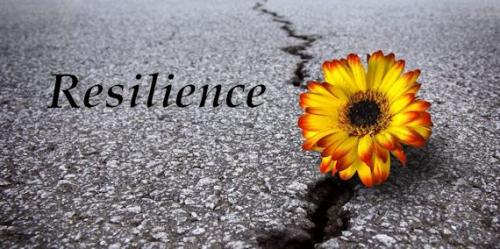
The process of converting a house to renewable energy begins with:
1. Upgrading its passive solar features, then,
2. Tightening the envelope through adding insulation, upgrading windows, and so forth.
3. The next stage is adding solar hot water heating. Heating water accounts for a quarter to a third of energy usage in a home and using solar water heating can substantially cut the energy bill.
4. Then PV.
5. And then whatever is still needed.
Let's look at three options for adding solar water heating to our homes.
We're now starting to look into solar hot water - hopefully to install before this coming winter, finances depending. (Yes, winter is coming :=) Here's what I've learned so far.
1. Older Tube Solar Hot Water Technology
Here is a good explanation of the older process http://www.solarhotwaterheaters.org
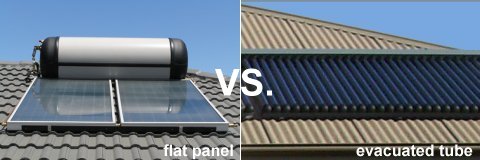
There are 2 types of solar heat collectors - Flat plate solar collectors and evacuated tube solar collectors.
Evacuated tubes are glass tubes with a vacuum inside them and copper pipes are in the center.
Heat is drawn from the dark glass and absorbed into the copper pipes which share a manifold where a circulating pump moves the heated water into a insulated storage tank. This storage tank allows the water to be used that night or the next day.Flat plate collectors work using copper lines running in a glass covered collector which sometimes has a external storage tank right on the unit. The hot water can then be drawn right from the tank.
Evacuated tube collector based systems are the better choice:
- Captures more sunlight as they have a greater surface area exposed to the sun
- Are more efficient in the transferring heat
- Can be used in freezing temperatures
- If a tube breaks, it can be replaced
- Excellent operation in overcast conditions on cloudy days
- Require a smaller roof footprint compared to flat plate collectors
- Low level of corrosion problems compared to flat plate collectors
2. New PV Hot Water Systems
Martin Holladay is senior editor at Green Building Advisor, a site filled with tasty goodies.
http://www.greenbuildingadvisor.com/team/martin-holladay-gba-advisor
He concluded in the late 200s that the drop in PV costs and the relative simplicity and less maintenance makes solar thermal obsolete. He revisited it in 2014 and found that the case ws then overwhelming for PV solar heating systems.
Comparing three systems
My latest approach to comparing the cost of solar equipment used to make domestic hot water starts with the assumption that the typical solar fraction of a cold-climate solar thermal system is 63%.
Keeping that solar fraction in mind, I have calculated the cost of equipment for three scenarios:
House A has a solar thermal system (two rooftop collectors and a solar storage tank in the 80 to 120 gallon range) and an electric-resistance water heater for backup.
House B has an electric-resistance water heater and a PV system sized to provide enough electricity on an annual basis to meet 63% of the family’s hot water needs.
House C has a heat-pump water heater and a PV system sized to provide enough electricity on an annual basis to meet 63% of the family’s hot water needs.
The table below compares three homes in Boston, each of which uses 44 gallons of domestic hot water per day.
According to this analysis, the PV plus electric-resistance approach is about 25% cheaper than the solar thermal route, and the PV plus heat-pump approach is about 50% cheaper than the solar thermal route.Everyone's numbers are going to be different
What if you are a solar thermal buff who thinks that my assumptions are unfair to solar thermal? Well, let’s change a few numbers. We’ll assume that a solar thermal system costs only $6,000 to install and that the solar fraction is 75%.
I think that the assumptions made in the above table are unrealistic, since it's hard to find a contractor willing to install a good two-collector solar thermal system for $6,000, and because in a location with a solar fraction of 75% a PV system is likely to produce more electricity than this table shows. But according to this analysis, the PV plus heat-pump approach is still about 23% cheaper than the solar thermal route.http://www.greenbuildingadvisor.com/blogs/dept/musings/solar-thermal-rea...
3. Geothermal
Then there's the enticing option of geothermal, where technology has also vastly improved.
Today's geothermal uses 3' copper tubing instead of the old space-eating gigantic plastic loops.
Which means the heating and cooling system can also heat water.
I'm looking at an installer in Ottawa, http://www.geothermalexperts.ca/products_earthlinked_heating.php.php.
They are a dealer for the products of a U.S. company called Earthlink Technologies http://earthlinked.com/products/
Here's the three earth loop options available:
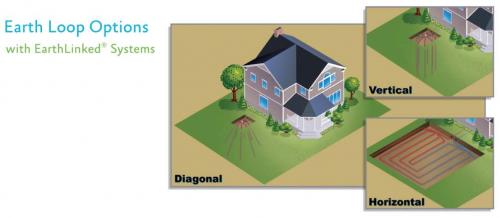
http://www.geothermalexperts.ca/pdf/DXEarthLoops-Options.pdf
Here's their marketing spiel:
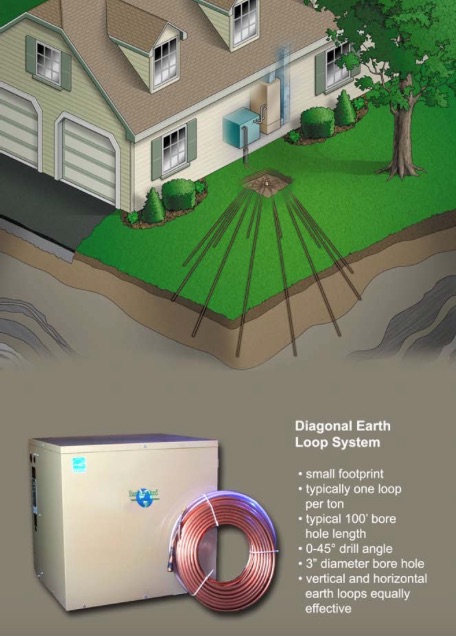
http://www.geothermalexperts.ca/pdf/EarthLinkedSHC-factsheet.pdf
Solar Energy from the Shallow Earth
Reduced fossil fuel consumption, reduced emissions and increased comfort result from the use of renewable solar energy stored in the shallow earth. These benefits are delivered by the EarthLinked® heat pump system.Almost half of the sun’s energy that reaches the earth is stored in the ground, resulting in a solar battery that can be used for heating anytime, anywhere that people live. The constant and favorable temperature of the earth also makes it a favorable heat sink to receive unwanted heat in the cooling season.
The EarthLinked system is a heat pump that uses the refrigeration cycle to move heat from one location to another, like an air conditioner that can also operate in reverse. It’s a unique heat pump because the patented refrigerant flow controls enable it to directly connect with small earth loop tubes that can be installed vertically, diagonally or horizontally in 3” bore holes 50 to 100 feet (15 to 30 m) in length. Typically, the earth loops are 100 feet per ton (12,000 BTU) of capacity.
The diagonal loop configuration exchanges heat in a large subsurface area but impacts a small six foot diameter area at the surface during installation. The system, the earth loops and the boring equipment are small, so the installed footprint is small and the system is very adaptable for retrofit installations.
Because of its efficient use of the favorable earth temperature as a heat source/heat sink and its direct heat exchange method, the EarthLinked system is more efficient than an air source heat pump (ASHP) and other geothermal heat pump (GHP) units that must circulate water for heat exchange.
One System, Multiple Uses
Whether you live in Australia or Alaska, the EarthLinked system is the simple solution to a comfortable environment throughout your home. A single unit can provide space heating and cooling, and water heating, no matter the climate conditions. Because of its small size and mechanical simplicity the system is convenient, reliable and easy to maintain.Space Heating and Cooling
Thousands of property owners in North America and around the world use EarthLinked to heat or cool buildings. The system delivers a stable, comfortable temperature all year round. In summer there is a greater dehumidification because of colder refrigerant coils and longer run cycles. In winter there are no blasts of hot air as with a furnace, and the heated air is warmer than with an air source heat pump because the earth is a warmer heat source. For maximum winter comfort and efficiency, the EarthLinked system can also be coupled with a radiant hydronic system.Water Heating Option
You can use the EarthLinked system to heat water up to 125°F (52°C), optimizing your energy consumption and saving money. The system uses waste heat given off in the air‐conditioning mode in summer or natural heat stored in the ground and harvested by the heating mode in winter. Either way, you can reduce your water‐ heating costs by as much as 75% compared to electric resistance heating.Swimming Pool Heating
No matter the size of your pool, the EarthLinked system can quietly heat the water to a comfortable temperature without harmful combustion byproducts— all with the highest efficiency.http://www.geothermalexperts.ca/pdf/EarthLinkedSHC-factsheet.pdf
So those appear to be the three options for solar thermal:
- Older Tube technology, as a stand-alone system
- New lower-cost PV, in combination with a house solar electricity system
- Geothermal, in combination with air heating and cooling
We're not ready for a full PV system. Plus, there are no more green subsidies in Canada, except possibly in geothermal. Perhaps, maybe...
I think though, I'm going to ask for a quote for the geothermal option.
I'd appreciate any feedback and guidance from your experience possible.
Peace be with us, if we work to make ourselves energy-independent,
gerrit

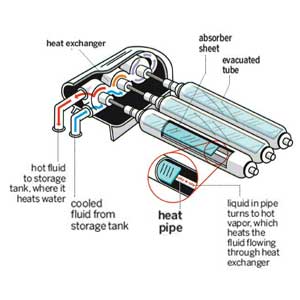
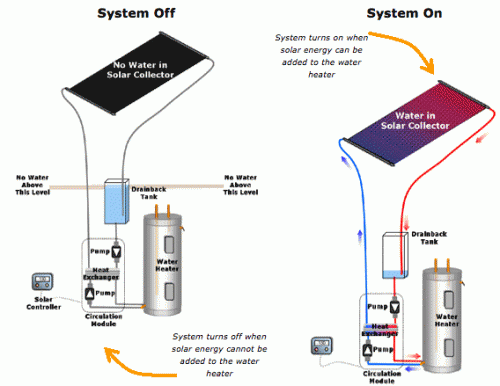
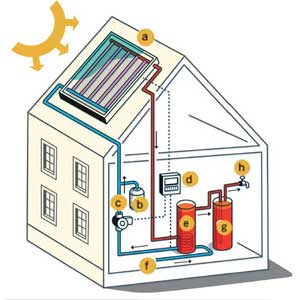
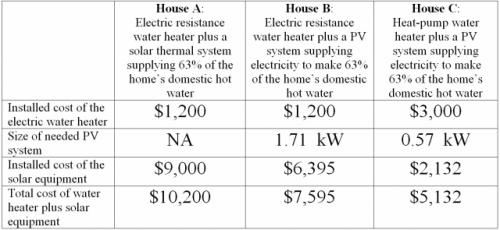


Comments
This looks good Gerrit
I've just done a quick scan. I'll come back and read it better and travel the inertube links after running a few errands.
All the best..have a good one.
“Until justice rolls down like water and righteousness like a mighty stream.”
TY Lookout. I think you already have solar hot water, eh?
Enjoy your day, my friend,
Resilience: practical action to improve things we can control.
3D+: developing language for postmodern spirituality.
Thank you for this
The 'new' house is soon to have a solar water heater. I have long been familiar with the old style, and liked its apparent simplicity. This gives me a lot to think about .
"I’m a human being, first and foremost, and as such I’m for whoever and whatever benefits humanity as a whole.” —Malcolm X
You're welcome Bisbo. I was also surprised. I had lots of info
on the vacuum tube tech and was going that way when I started researching. I think the tube system would work fine for you in your hot climate. Here its the swing from hot to cold that causes fatigue in the system. I'm really intrigued by the new geothermal though. That's a neat combo. Let us know which way you decide to go, eh.
Resilience: practical action to improve things we can control.
3D+: developing language for postmodern spirituality.
There's so much potential here, G.
The roof is a royal pain to get to. We've got no footprint for geothermal.
A few years ago we got tired of replacing water heaters every couple of years. Seems like they used to last at least 10 to 15 years. Then all of a sudden that only lasted 2 to 3. FTS!
I'd been reading about tankless heaters. So we decided to take the plunge. We replaced the tank heater for this whole-house tankless.
This isn't the exact same model but the specs are equivalent. It reduced our gas bill dramatically.
Improve the Resilience Resource Library by adding your links.
Vote Smart - Just the Facts - 40,000 politicians by name or zipcode
Right on, AB, that sounds like a real good plan, mate. I'll
follow the link. BTW, I haven't sent you a phone nr cause I've got another lead on totes who might deliver. Then I could get like three of them or so. I hope to hear back on Tuesday when business opens after Victoria Day. Cheers, mate,
Resilience: practical action to improve things we can control.
3D+: developing language for postmodern spirituality.
We've had the pilot light go out a couple of times in seriously
bad storms. The wind would blow down the flue and put the pilot light out. Not a problem because the thing has a shutoff that stops the natural gas at that point. It's a small matter to relight it because of the piezo igniter. But it's infrequent.
Whoa! three tanks? Now you're talking some serious weight. 3 tons You really need 750 gallons? That's a lot of agua, amigo. And if you're going to install the tanks in tandem you're also looking at a serious structure to support it all.
By "serious structure" I mean piers that go below the frost line and a pad to spread the weight. Personally, I'd be inclined to build something like that from light steel instead of wood. (But wood would work too if it was substantial enough.) Then clad the framework in wood (plywood or cedar shingles.)
Improve the Resilience Resource Library by adding your links.
Vote Smart - Just the Facts - 40,000 politicians by name or zipcode
Ah, my bad for not explaining properly, mate: one for the side
yard beds, one for the front gardens, and one for the back yard. Sorry!
Resilience: practical action to improve things we can control.
3D+: developing language for postmodern spirituality.
Is There An ENGINEER In The House?
Mrs.G going to appreciate seeing these beasties all around the house? You might get better pressure if you gang them together. Not to mention having to build only one frame.
Engineer person: G wants to build a water tower. See the thread above.
I'm not a bona fide engineer. I just have decades dealing with heavy loads. (Precast concrete) Other stuff too. My concern is putting so much weight up in the air without an adequate foundation.
Now he wants to build 3 towers. I've just suggested building 1 only.
What do you think?
TIA,
AB+G
Improve the Resilience Resource Library by adding your links.
Vote Smart - Just the Facts - 40,000 politicians by name or zipcode
Oh crickey, you're right :=) When you put it that way, I see the
lunacy! Yikes, thanks mate, for cutting through my madness. When I show this to Lovie, she'll be real glad I've met up with you, AB. I can get so ahead of myself sometimes...
Remind me I owe you a case of beer sometime :=)
Resilience: practical action to improve things we can control.
3D+: developing language for postmodern spirituality.
My mission in life is to grab
Icaruses (Icarii?) by the ankles before it's too late.
Meanwhile back at the ranch...
Have you used your hose meter doohickey?
Know yet how much water each of these beds needs for a good soaking?
Done your meteorology research? (hint: how long between typical rainfalls)
Measured your collector roof? (length*width=sq.ft./12= "x"cu.ft., 1cu.ft.=7.48gals.)
By the way, got a FLASH PRIORITY URGENT cable from Lovie earlier: "AB, for the love of all that's soft and furry, please talk some sense into the old fossil."
Got your six, bro.
Improve the Resilience Resource Library by adding your links.
Vote Smart - Just the Facts - 40,000 politicians by name or zipcode
A great morning to you, AB! Lovie had a good laugh; she's real
glad I've met up with you :=) On the beds: I'm still hardening off seedlings; I am 2 weeks behind this year.
On the totes: Lovie agrees - slow down, do AB's math properly, then make a good plan. She wants me to clad the container and platform in the same siding as the house. Sigh...well, it would look good.
TY for all the help, mate! BTW, now with summer here, I'm real busy. I'm going to slow down on resilience posts until Labour Day or so and enjoy the outside work. Probably like 2-3 a week until then.
Have a great day, AB,
Resilience: practical action to improve things we can control.
3D+: developing language for postmodern spirituality.
Good morning, Gerrit. Happy Day, Mate.
I'm way behind too. My beans should be little shrubs by now and they're just breaking ground. Nor the weather's fault. I got in a funk at the wrong time. Well, better late than never, eh?
Don't sweat it, mate, you're not the first "architect" I've met who hollered "Giddiup!" before the team was hooked up to the wagon.
My formula is misspelled. It should read: L*W*12=cu.ft. But you probably figured that out by now. You may not need to actually use the hose to find out how much water you need. But you do need to know how many sq.ft. of garden you have.
I did a quick calculation of Bidet Acres and have 160sq.ft. of garden. I use about 30/35gals. for a good soaking. Hence, 0.21875 gals./sq.ft. @ 35gals. for the calculation. Round off to 1/4gal./sq.ft. for simplicity. (When rounding stuff off, I go with heavier, or more need, or longer duration. It helps to overestimate a little to avoid coming up short.)
So now you know how big your beds are. You've got "X" sq.ft. of garden. Divide by 4 to get sq.ft./gal.
Now you know how far 250 gallons will go. (Up there, you may not really need more than 1 tote.)
Now you use your memory or wunderblog to trace historical weather patterns. (Typically how long between rains. How much rain in typical months of gardening.)
I'm with Lovie on cladding the whole water tower for a couple of reasons.
First, UV will degrade the tote in 4, 5 years at the most. Exposure to severe weather will also make short work of your endeavour.
Second, only partially clad, (the lower part for a mini-shed), the rest will be most unsightly.
Some measurements to take into consideration.
How far off the ground is the drain from the roof? The gutter that will supply the tote?
Subtract the downspout elbow and a slight slope for the typical downspout pipe to feed the tote. That's the determining elevation for the top of tote inlet.
When building the tower frame, make sure to leave 2 feet between the tower and the house. This is to have room to get to the inevitable leaves and debris that invariably collects next to houses.
What is your house clad with now?
Have you gotten dimensions of the tote yet?
~~~~~~
I'm putting together a compost essay, but the compost isn't ready for prime time yet.
Take advantage of the outdoors while you can, mate.
Improve the Resilience Resource Library by adding your links.
Vote Smart - Just the Facts - 40,000 politicians by name or zipcode
The Bosch unit looks real good, AB. And the reviews are good
too. Folks say its simple to install and works great. Good one, mate,
Resilience: practical action to improve things we can control.
3D+: developing language for postmodern spirituality.
Thanks Gerrit
Good topic. I'm building a low tech heat exchanger to pre-heat the water coming out of the well before it gets to the boiler circuit. Have to use glycol, but the heater design from Mother Earth is simple and easy. Can't see spending over a grand for a collector when, for a bit less efficiency, $120 will do the job. Will dig out links if interested.
Scott
Thought is the wind, knowledge the sail, and mankind the vessel.
-- August Hare
Morning and thanks for this, QMS. Yes, we'd love to see the
links if you can dig them out. Please and thank you :=) And you're so right - hooray for DIY. And Mother Earth sure has great stuff; we're also long-time subscribers. Enjoy your day, my friend,
Resilience: practical action to improve things we can control.
3D+: developing language for postmodern spirituality.
solar water heater
Hey Gerrit -- Here is the link. It is an older one from 1981. I think I found it thru Backwoods Home Magazine.
http://www.motherearthnews.com/diy/flat-plate-solar-collector-zmaz81jfzr...
Thought is the wind, knowledge the sail, and mankind the vessel.
-- August Hare
Good morning, QMS and TY for the link. I like Backwoods DIY
articles myself. I'll go explore the link. Enjoy your day today,
Resilience: practical action to improve things we can control.
3D+: developing language for postmodern spirituality.
You are more than welcome.
I will endeavor to dig up another good solar thermal link.
Thought is the wind, knowledge the sail, and mankind the vessel.
-- August Hare
in Hawaii I saw mostly the flat panel system with
the storage unit right on top of the panels on the roof. Must work pretty well, considering how many I saw. I am imagining Greenhouses with panels in combination with water catchment systems, so that you don't have the hassle with panels on the roof to clean. But I haven't researched for it. First comes the land, then come the facilities. Hopefully before I die.
I will come back to this series for long time to come. Very nice to have that here.
https://www.euronews.com/live
Morning mimi and thank you. Yes, the flat panels work better
in the warm climates and the tubes work better in the cold climates. And you're so right: first comes the land. Lovie and I are going through that at the moment. We've had no luck selling our house. We gave up and are staying until the last kid finishes high school next year. Our plan is to move to an acreage then. But I'm so pessimistic: I feel like just settling here, while Lovie is the optimist telling me to hang in there. Well, the universe will tell us soon enough.
Thanks, mimi and enjoy your day, my friend. Hey, it sure was nice to see how well your fundraiser turned out! What a great idea and I hope you'll do it again.
Resilience: practical action to improve things we can control.
3D+: developing language for postmodern spirituality.
I have a near-neighbor who drilled for GT
She already has PV, battery storage, moderate illumination until winter. I think PV panels in a field. Small house, has added on GT. And I have no idea how she does DHW. Investigating goes slowly.
Hey! my dear friends or soon-to-be's, JtC could use the donations to keep this site functioning for those of us who can still see the life preserver or flotsam in the water.
I forgot.
An earlier system here was roof DHW, glycol exchange, 80 gal storage. Worked for winter until kids and long showers. Added upper element electric circulator to that tank. Electric baseboard heat, at some point using 3X200 gal steel storage tanks and elements and many pumps in a basement with no floor drain. Tank integrity became a worry. Now tankless, many pumps. Propane bomb near house. Thinking. On zero budget. Reliant on home water well.
Hey! my dear friends or soon-to-be's, JtC could use the donations to keep this site functioning for those of us who can still see the life preserver or flotsam in the water.
Morning riverlover, Ty for this and have a great day, my friend.
Resilience: practical action to improve things we can control.
3D+: developing language for postmodern spirituality.
I have a flat panel solar water heater here in FL
and, IIRC, the panel holds about 60 gallons, so I in effect have two water heater "tanks"; the one on the roof, and the standard water heater in the house. Unfortunately, I have no idea how much electricity its saving me.
I'm quite interested in geothermal, and I think I have a good place for a horizontal system; the median of my driveway. But first I want to convert my attic to a closed attic, with dense-pack cellulose (I hate the idea of foam, with its potential for outgassing and its heavy carbon footprint). Alas, here in Florida, dense-pack cellulose, especially for rafters, is rare as hens' teeth. I'll be doing the prep work myself, then find someone who blows (borate-only) cellulose into walls.
BTW, that's some really big pipe; "Today's geothermal uses 3' copper tubing". ;^)